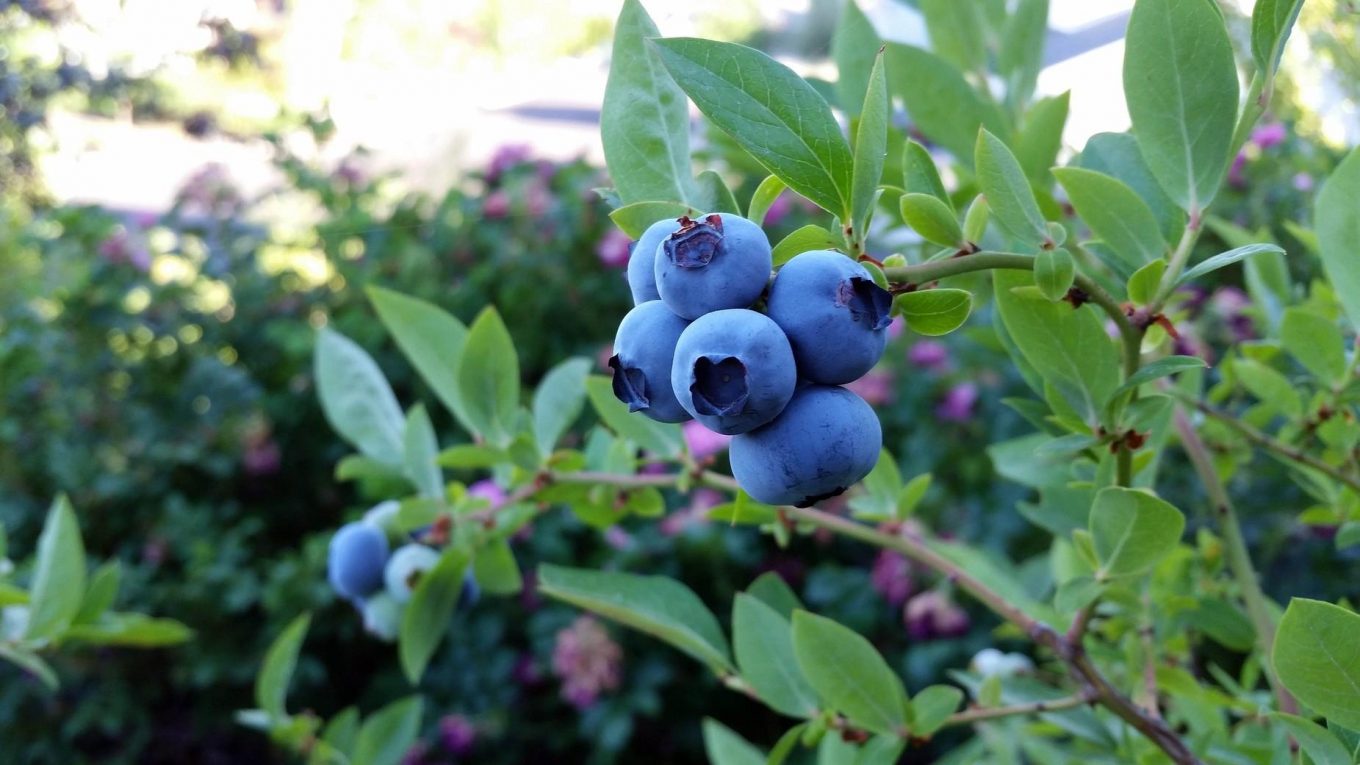How to Grow Blueberries
In This Article
Back to Top
Along with producing fruits that can bring a sweet, healthy addition to your diet, blueberry bushes are easy to grow with a slow-to-moderate growth rate. Blueberries can be planted directly in the ground, form landscape shrubs in your yard, or grow in pots to add a pop of color to your patio.
Blueberries include several species of flowering, fruiting shrubs within the Vaccinium genus, all native to North America. Relatives within the Vaccinium genus include the bilberry, cranberry, huckleberry, and lingonberry.
Blueberry bushes have pointed, oblong leaves that are leathery to the touch and turn a brilliant red color in the fall. The flowers appear in clusters of small, white, bell-shaped blooms in the late spring, leading to deliciously edible berries that ripen from green to a deep purple-blue.
Quick Tips for Growing Blueberries
- Start growing blueberries in early spring in full sun and acidic soil.
- Expect it will take at least three growing seasons before a moderate harvest; a more meaningful harvest comes after six years.
- Cultivated berries usually have higher yields and more heat and cold tolerance; wild berries generally are smaller but often sweeter.
Click Play to Learn How to Grow and Harvest Blueberries
:max_bytes(150000):strip_icc()/blueberries-vaccinium-spp-3269245-05-27b7ac2ad5f84d71b6943f2e1991bd8d.jpg)
:max_bytes(150000):strip_icc()/blueberries-vaccinium-spp-3269245-04-847f71d51a7248f8bf9eebf705e8d06a.jpg)
:max_bytes(150000):strip_icc()/blueberries-vaccinium-spp-3269245-06-7bc02b18567e4c7fa089284d2475b54b.jpg)
Types of Blueberries
There are four main types of blueberry plants: highbush, lowbush, half-high, and rabbiteye. They are primarily classified by their size, and plant breeders continue to cultivate new varieties to improve their vigor. The main types include:
- Highbush (Vaccinium corymbosum) is a roughly six-foot shrub hardy in zones 4 through 7. This is the most common and most productive type of blueberry. Varieties good for cold winters include ‘Bluecrop,’ ‘Blueray’. ‘Herbert’, ‘Jersey’, and ‘Meader’. Types known for big berries include ‘Berkeley’, ‘Bluecrop’, ‘Blueray’, ‘Coville’, ‘Darrow’, and ‘Herbert’, There is also a variety that produces pink berries called ‘Pink Lemonade.’
- Southern highbush (hybrids of V. virgatum, V. corymbosum, or V. darrowii) is considered somewhat hard to grow, but several cultivars are popular for Southern gardens, including ‘Emerald’, ‘Windsor’, and ‘Springhigh’, These are shorter, three- to six-foot-tall bushes with a four- to five-foot spread. They are grown in zones 7 through 10.
- Lowbush (Vaccinium angustifolium) are bushes well suited for the coldest climates, as far north as zone three. They have a much different growth habit from other types, growing about one foot tall and spreading in a creeping fashion. Native to the northeast U.S. and southern Canada, the berries have a waxy covering that makes the fruit look gray in color. These are sometimes considered wild blueberries, and there aren’t many named cultivars available.
- Half-high blueberries are a newer breeding development, including varieties developed by crossing highbush and lowbush species. Most of these grow 18 to 48 inches high. Popular cultivars include ‘North Country’, ‘Northblue’, and ‘Northland’. The berries are typically a little less sweet than highbush blueberries, but they work well in pies, jams, and preserves.
- Rabbiteye (Vaccinium virgatum) was previously categorized as Vaccinium ashei. It is grown mostly in the southeastern U.S. Growing as high as 15 feet, it requires two or more varieties to pollinate correctly. Recommended varieties include ‘Powderblue’, ‘Woodard’, and ‘Brightwell’, ‘Delite’ is another good late-bearing variety. Rabbiteye blueberries are great choices for gardens in zones 7 through 9.
Blueberries vs. Huckleberries
Blueberries and huckleberries come from the same genus. The fruits look similar at first glance: they’re both small and round with a blueish color. However, huckleberries tend to be more tart than blueberries, and their seeds are noticeably hard when you bite into them (unlike blueberry seeds).
Harvesting Blueberries
Blueberries will typically be ready to harvest between June and August. Most blueberry plants start to produce fruit by their third year, but they won’t produce fully until about their sixth year. Mature blueberry bushes yield around eight quarts of berries per bush. It’s possible to extend your blueberry harvest by planting two or more bushes, such as early-, mid-, and late-season varieties.
The only reliable way to know whether blueberries are ready to pick is to taste them. Ripe blueberries will readily come off the stem. Blueberries are their sweetest if allowed to stay on the plant for at least a week after turning blue. Hold a container under berry clusters, then gently pick them off with your other hand to drop the fruits into the container. Put them in the refrigerator, unwashed as soon as possible. They typically can keep up to a week when refrigerated (wash them before use). The berries can be eaten fresh or used in baked goods, and they also can be frozen and kept in the freezer for around 6 to 12 months.
Growing Blueberries in Pots
Blueberries are one of the easiest berries to grow in containers. They are popular in home gardens because they can grow in small spaces, including containers. Containers are especially ideal if you don’t have adequate soil conditions for blueberries. Use a container at least 18 inches deep with ample drainage holes. An unglazed clay pot is ideal because it will allow excess soil moisture to escape through its walls.
Use one container per plant and choose a blueberry variety that remains fairly small. Select a potting mix made especially for acid-loving plants, then plant your blueberries at the same depth they were in the nursery pots. Keep the soil lightly moist but never soggy, and make sure the container gets plenty of sunlight. Use a fertilizer made for acid-loving plants in the spring.
How to Grow & Care for Blueberries in Containers
Pruning
Blueberries will continue producing at their best with some maintenance pruning. In the first two years, remove any flowers that appear to help your plants grow bigger and more vigorous. You can leave the flowers on for the third year. They won’t produce many berries, but no pruning is necessary until the fourth year.
Beginning in the fourth year, prune your blueberry bushes in late winter or early spring while they are still dormant. A good rule of thumb is to prune about 1/3 of the plant to encourage new growth. Using clean, sharp garden shears or a small wood saw, remove any dead, broken, crossed, or weak branches where they meet the main stem. The goal is to open up the bush so light can reach the middle, so it’s also important to trim any branches that cross each other.
Maintenance pruning in subsequent years should aim at thinning out the older branches. Cut back the oldest, thickest branches to near ground level, then prune back branches that have grown too long or too thin. Older branches will look gray in color; newer branches will have more of a reddish tinge.
Propagating Blueberries
Like many woody shrubs, blueberries can be propagated by rooting cuttings taken from softwood or hardwood. Not only is this a cost-effective way to get a new plant, but it also helps to thin out mature plants. The best time to take softwood cuttings is in the early spring, while hardwood cuttings are best taken in late winter before new growth begins. Here’s how:
- Choose a healthy branch. Use pruners to cut off the last five inches of growth from the tip of the branch, then remove all but the top two or three leaves.
- Apply a rooting hormone to the cut end.
- Plant the cutting in a moistened soilless potting mix in a small container. Place the container in a warm room that isn’t exposed to drafts or temperature fluctuations.
- Keep the container in bright, indirect light, and make sure the growing medium stays moist but not soggy. It can take a few months for the cutting to root.
- Once new leaves have developed and you feel resistance when gently tugging on the cutting (indicating that it has grown roots), it is ready to be planted in the garden. For hardwood cuttings, wait until spring to transplant outdoors.
How to Grow Blueberries From Seed
Before blueberry seeds can be planted, they must first be put in the freezer for 90 days to mimic the winter cooling period. You can grow blueberries from fruit by freezing the blueberries, then mashing them or putting them in a blender or food grinder. Once macerated, the seeds sink to the bottom. Collect the seeds by separating them from the juice and pulp.
Fall is the best time to plant seeds in warm climates, while spring is best in cool climates. Fill a flat tray with moistened sphagnum moss, sprinkle the seeds on top, then lightly cover them with more moss. Cover the tray with newspaper and place it in a room that stays between 60 and 70 degrees Fahrenheit. Keep the moss consistently moist.
Seedlings should emerge in about a month, at which point you can remove the newspaper and keep the tray in bright, indirect light. Once the seedlings are two to three inches tall, they can be planted in an equal mix of peat moss, sand, and soil. Continue to keep them moist. They should be large enough to plant in the garden during the spring of their second year after the threat of frost has passed.
Potting and Repotting Blueberries
You should start growing blueberries in as large of a container as possible. If you see roots emerging from drainage holes or the top of your container, it’s time to repot into something larger. Choose a container that comfortably fits the root ball.
Fill your container with fresh potting mix or a soilless medium of equal parts shredded pine bark and sphagnum peat moss. After removing the plant from its current container, gently shake off any excess soil. Replant the shrub at the same depth it was in its previous container. Keep the soil moist, but not soggy.
Overwintering
Blueberry bushes go dormant over the winter, and they’re generally hardy to the coldest conditions of their hardiness zones. However, they can be susceptible to fluctuating winter temperatures that trigger new growth. If your blueberries are growing in pots, it’s helpful to cover them in frost blankets to minimize freezing air and wind chills. To protect the bushes in the ground and maintain consistent soil temperatures, add a layer of mulch around them before the weather gets cold.
Common Pests and Plant Diseases
By far the biggest problem growing blueberries is keeping birds at bay. Placing bird netting over your blueberries or using a scarecrow can be successful if you have only a few bushes, but if you have a large blueberry patch, consider trying a bird deterrent that sends out a bird-in-distress call to repel birds.
Insects to be on the lookout for include: scale, blueberry tip borer, cherry fruit worm, cranberry fruit worm, and plum curculio. If these are common pests in your area, check with your local extension for the prescribed deterrents and treatments.
There are some fungal diseases that can affect blueberries, including powdery mildew and rust (which can be treated with neem oil) along with leaf spot diseases. Your best defense is to plant genetically resistant varieties. It also helps to give your plants plenty of space for good air circulation, plant them in full sun, clean up any fallen debris, and replace the mulch annually so that fungal spores cannot overwinter in the area. If you experience these problems, you might need to use a fungicide labeled for use on edible plants.
Some other common blueberry diseases to be aware of include:
- Anthracnose: This fungal disease spreads rapidly in damp weather. Symptoms are bright pink clusters of spores on the developing berries.
- Botrytis: Another fungus that thrives in damp conditions, botrytis will cause the fruit to shrivel and rot.
- Canker: This disease begins in the lower parts of the canes. You’ll notice small reddish spots that will enlarge into a bullseye. If left untreated, they will eventually circle and girdle the cane, causing it to die back.
- Mummy berry: This is one of the more serious diseases to affect blueberries. Mummy berry is caused by a fungus. The first sign of an infestation is the blackening of flower clusters, which eventually die. Because it is a fungus, the spores can linger and infect the remaining blossoms. The resulting fruit turns tan and hard, looking like mummified berries.
- Twig blight: Twig blight can start off looking very similar to canker. As twig blight progresses, it can affect the crown, smaller branches, and twigs, and it can also cause leaf spotting.
Are blueberries easy to grow?
When given their preferred environment, blueberries are quite easy to grow, and they even do well in containers. These plants require full sun and acidic soil to thrive and produce fruit.
How long does it take to grow blueberries?
Blueberry bushes grow slowly and can take six years to reach their full fruit production. Pruning is key to producing fruit: After the first three years, begin pruning your plant to encourage new growth.
Do you need two blueberry bushes to produce fruit?
Blueberries can self-pollinate, so you will be able to harvest fruit with only one type of blueberry bush. However, planting multiple varieties for cross-pollination results in a higher yield and larger fruit. However, you must ensure that all varieties flower at the same time.
Article Sources
The Spruce uses only high-quality sources, including peer-reviewed studies, to support the facts within our articles. Read our editorial process to learn more about how we fact-check and keep our content accurate, reliable, and trustworthy.
- Keys to Establishing a Successful Blueberry Planting. PennState Extension


:max_bytes(150000):strip_icc()/blueberries-vaccinium-spp-3269245-09-6db237751a984675b7e11d5f37301520.jpg)
:max_bytes(150000):strip_icc()/growing-blueberries-in-containers-848170-step-01-bf5f3209ecb8418b8b24ada86ec622c5.jpg)





